The AMD Ryzen 9 3950X Review: 16 Cores on 7nm with PCIe 4.0
by Dr. Ian Cutress on November 14, 2019 9:00 AM ESTCPU Performance: System Tests
Our System Test section focuses significantly on real-world testing, user experience, with a slight nod to throughput. In this section we cover application loading time, image processing, simple scientific physics, emulation, neural simulation, optimized compute, and 3D model development, with a combination of readily available and custom software. For some of these tests, the bigger suites such as PCMark do cover them (we publish those values in our office section), although multiple perspectives is always beneficial. In all our tests we will explain in-depth what is being tested, and how we are testing.
All of our benchmark results can also be found in our benchmark engine, Bench.
Application Load: GIMP 2.10.4
One of the most important aspects about user experience and workflow is how fast does a system respond. A good test of this is to see how long it takes for an application to load. Most applications these days, when on an SSD, load fairly instantly, however some office tools require asset pre-loading before being available. Most operating systems employ caching as well, so when certain software is loaded repeatedly (web browser, office tools), then can be initialized much quicker.
In our last suite, we tested how long it took to load a large PDF in Adobe Acrobat. Unfortunately this test was a nightmare to program for, and didn’t transfer over to Win10 RS3 easily. In the meantime we discovered an application that can automate this test, and we put it up against GIMP, a popular free open-source online photo editing tool, and the major alternative to Adobe Photoshop. We set it to load a large 50MB design template, and perform the load 10 times with 10 seconds in-between each. Due to caching, the first 3-5 results are often slower than the rest, and time to cache can be inconsistent, we take the average of the last five results to show CPU processing on cached loading.
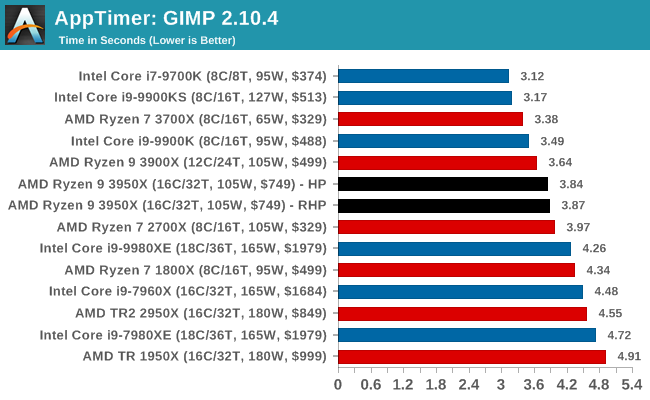
As a raw single threaded test, we see Intel's high 5.0 GHz CPUs near the top. The Ryzen 3700X and Ryzen 3900X beats the 3950X here by small margins, perhaps due to memory traffic or the complexity of dealing with more cores in the system. However the Ryzen 9 3950X sails past Intel's HEDT chips.
3D Particle Movement v2.1: Brownian Motion
Our 3DPM test is a custom built benchmark designed to simulate six different particle movement algorithms of points in a 3D space. The algorithms were developed as part of my PhD., and while ultimately perform best on a GPU, provide a good idea on how instruction streams are interpreted by different microarchitectures.
A key part of the algorithms is the random number generation – we use relatively fast generation which ends up implementing dependency chains in the code. The upgrade over the naïve first version of this code solved for false sharing in the caches, a major bottleneck. We are also looking at AVX2 and AVX512 versions of this benchmark for future reviews.
For this test, we run a stock particle set over the six algorithms for 20 seconds apiece, with 10 second pauses, and report the total rate of particle movement, in millions of operations (movements) per second. We have a non-AVX version and an AVX version, with the latter implementing AVX512 and AVX2 where possible.
3DPM v2.1 can be downloaded from our server: 3DPMv2.1.rar (13.0 MB)
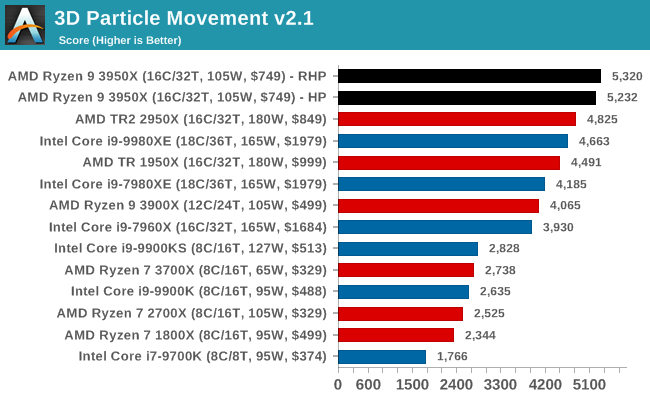
For some simple math without AVX acceleration, the 3950X piles on the core performance and IPC to give our best results, above and beyond what the Core i9-9980XE can provide for less power at under half the cost.
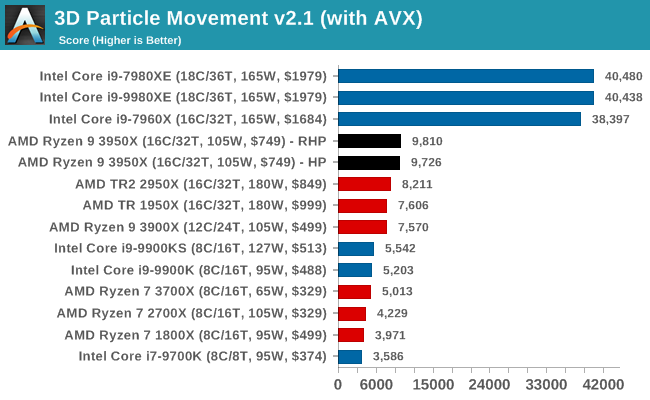
However, this is one benchmark where ratcheting in AVX2 and AVX512 really helps. There's no escaping the Intel HEDT family here, but on AVX2 mode AMD wins the best of the rest.
Dolphin 5.0: Console Emulation
One of the popular requested tests in our suite is to do with console emulation. Being able to pick up a game from an older system and run it as expected depends on the overhead of the emulator: it takes a significantly more powerful x86 system to be able to accurately emulate an older non-x86 console, especially if code for that console was made to abuse certain physical bugs in the hardware.
For our test, we use the popular Dolphin emulation software, and run a compute project through it to determine how close to a standard console system our processors can emulate. In this test, a Nintendo Wii would take around 1050 seconds.
The latest version of Dolphin can be downloaded from https://dolphin-emu.org/
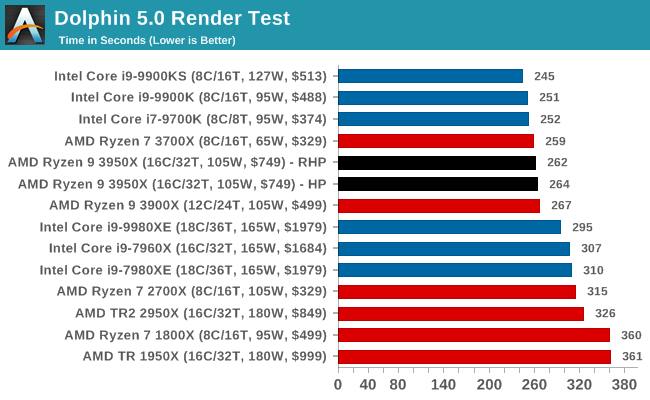
Dolphin is another ST test, and Intel's 4.7+ GHz family are ahead of AMD here. The 3700X is a smidgen ahead of the 3950X, perhaps due to having only one chiplet rather than two.
DigiCortex 1.20: Sea Slug Brain Simulation
This benchmark was originally designed for simulation and visualization of neuron and synapse activity, as is commonly found in the brain. The software comes with a variety of benchmark modes, and we take the small benchmark which runs a 32k neuron / 1.8B synapse simulation, equivalent to a Sea Slug.

Example of a 2.1B neuron simulation
We report the results as the ability to simulate the data as a fraction of real-time, so anything above a ‘one’ is suitable for real-time work. Out of the two modes, a ‘non-firing’ mode which is DRAM heavy and a ‘firing’ mode which has CPU work, we choose the latter. Despite this, the benchmark is still affected by DRAM speed a fair amount.
DigiCortex can be downloaded from http://www.digicortex.net/
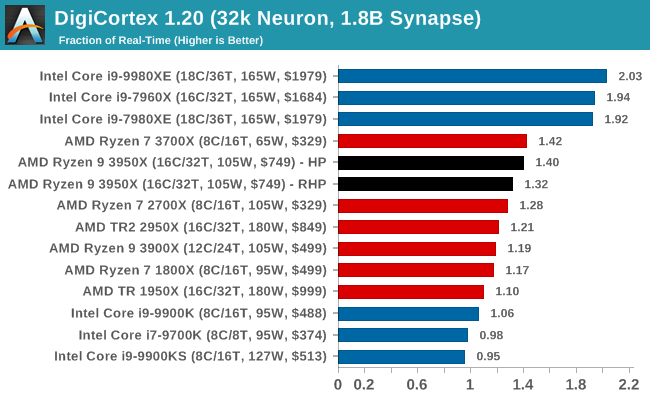
DigiCortex likes memory channels, and so Intel's HEDT chips win here. Again we see the 3700X beating the 3950X, likely due to the available bandwidth per core being higher and more cores not making much of a difference in performance.
y-Cruncher v0.7.6: Microarchitecture Optimized Compute
I’ve known about y-Cruncher for a while, as a tool to help compute various mathematical constants, but it wasn’t until I began talking with its developer, Alex Yee, a researcher from NWU and now software optimization developer, that I realized that he has optimized the software like crazy to get the best performance. Naturally, any simulation that can take 20+ days can benefit from a 1% performance increase! Alex started y-cruncher as a high-school project, but it is now at a state where Alex is keeping it up to date to take advantage of the latest instruction sets before they are even made available in hardware.
For our test we run y-cruncher v0.7.6 through all the different optimized variants of the binary, single threaded and multi-threaded, including the AVX-512 optimized binaries. The test is to calculate 250m digits of Pi, and we use the single threaded and multi-threaded versions of this test.
Users can download y-cruncher from Alex’s website: http://www.numberworld.org/y-cruncher/
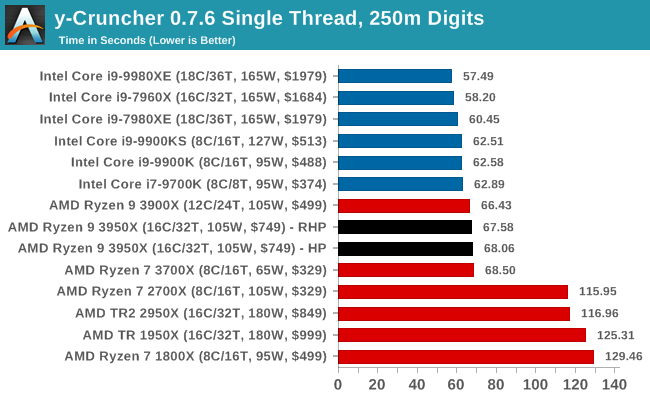
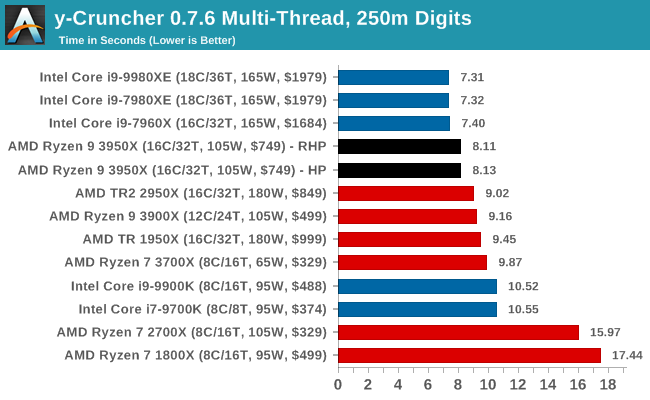
y-Cruncher is another piece of software that can use AVX-512, but AMD still comes very close. For single threadeded AVX2, the 5.0 GHz CPUs from Intel have a small lead, but in multi-threaded AVX2 the 16-cores with Zen 2 allow AMD to power through Intel's maintream offerings by 25%.
Agisoft Photoscan 1.3.3: 2D Image to 3D Model Conversion
One of the ISVs that we have worked with for a number of years is Agisoft, who develop software called PhotoScan that transforms a number of 2D images into a 3D model. This is an important tool in model development and archiving, and relies on a number of single threaded and multi-threaded algorithms to go from one side of the computation to the other.
In our test, we take v1.3.3 of the software with a good sized data set of 84 x 18 megapixel photos and push it through a reasonably fast variant of the algorithms, but is still more stringent than our 2017 test. We report the total time to complete the process.
Agisoft’s Photoscan website can be found here: http://www.agisoft.com/
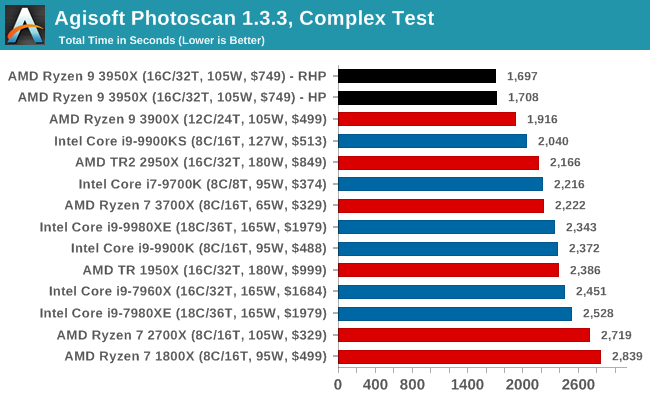
This variable threaded workload shows the power of AMD's 16 Zen 2 cores at a high frequency. Despite 5.0 GHz all-core turbo being on the 9900K, only having 8 cores lets it down here. Intel's HEDT line of processors just don't have the per-core performance to keep up.











206 Comments
View All Comments
Ian Cutress - Thursday, November 14, 2019 - link
Different software was saying different values depending on which sensor. I'm going to go back at some point and see if I can figure out why some were +30C over others.eastcoast_pete - Thursday, November 14, 2019 - link
Thanks Ian! I agree that, right now, the 3950X is King of the Hill in the HEDT space. Two minor flies in the otherwise good Zen 2 ointment:1. To fit the 3950X into the target thermal envelope, AMD reserves the best 7 nm dies for the 3950X, at least for now (pending Threadripper). While that makes sense business wise, it means a much lower chance for the rest of us to score a great die in the binning lottery. The fun with earlier Zen chips was that one could, with some luck, get a great die in a mainstream chip. Apparently, no more. The mainstream Ryzens are still very good, but the idea of getting a little something extra added appeal.
2. AMD has advertised the 3950X as targeted for liquid cooling. I know a lot of those who buy it will do so anyway, but there are some "air heads" left, including this one. I look forward to a comparison of liquid vs high-end and mainstream air coolers.
Overall, a great chip, that will keep Intel running to catch up, and that's good for all of us!
hansmuff - Thursday, November 14, 2019 - link
Isn't (1) pure speculation? As far as (2) goes, even with the 3900X AMD was saying that the top frequencies need enhanced cooling, and that's not particularly true. Even on a good AIO, we're not seeing the 3900X performing better than on good air. The 3950X has similar thermal envelopes, so I think a good air cooler will be just dandy.eastcoast_pete - Thursday, November 14, 2019 - link
The binning part (1) was mentioned in an article in golem.de . That site is usually pretty reliable, despite their name.abufrejoval - Friday, November 15, 2019 - link
While it's one of my favorites, too, I doubt that in this specific case they have any insights AT lacks. I believe they editorialized that part.But of course sophisticated binning is a core part of the CPU business these days.
And another good one with exclusive news gems every now and then is this one: https://elchapuzasinformatico.com/
Irata - Thursday, November 14, 2019 - link
Does AMD consider the 3950X to be HEDT ? Thought it was part of their mainstream platform.Ratman6161 - Thursday, November 14, 2019 - link
No. the 3950x is not HEDT. Its performance blurs the lines a bit but HEDT is more than just the CPU. Its also about PCIe lanes and RAM capacity etc.Ratman6161 - Thursday, November 14, 2019 - link
"the 3950X is King of the Hill in the HEDT space"The 3950x is not in the HEDT space. That's one of the most important conclusions I take away from this review. 3950x runs on a regular desktop motherboard (albeit an x570 to get full advantage of it). So besides just the price of the CPU itself, it makes everything about the system less expensive as well. My conclusion is that the 3950X is the best overall performance you can get from something that is not HEDT. This makes it much more accessible to us mere mortals...though personally I'm still looking at the 3700X.
eastcoast_pete - Thursday, November 14, 2019 - link
I guess one person's high-end desktop is another one's mainstream. I call a CPU that, yes, costs more than twice than a standard 8 core, yet is also faster than many other "HEDT" CPUs HEDT. In my view, HEDT is still below workstation levels, which have all the goodies you mention such as many more PCIe lanes, quad or more memory channels, support error correcting memory and lots of it, and are often multi-socketed. But then, the prices for these is eye-watering. But, regardless, this is a fast CPU.phoenix_rizzen - Thursday, November 14, 2019 - link
Time for another category, then. :)This is definitely a high-end desktop CPU. Runs in a mainstream desktop motherboard, and performs better than pretty much every other mainstream desktop processor.
Maybe it's time to call the Intel -X and AMD Threafripper lines "workstation-class" or "high-end workstation" or something along those line.
So you get desktop, workstation, and server. With low-end/high-end sub-groups for them.
So Athlon 3000G and Ryzen 3 would be low-end desktop. Ryzen 5 and 7, and the APUs, would be normal desktop. Ryzen 9 would be high-end desktop.